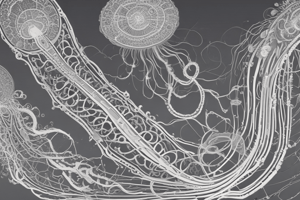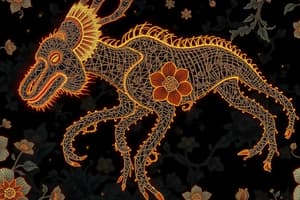Podcast
Questions and Answers
Which of the following scenarios would most likely lead to allopatric speciation?
Which of the following scenarios would most likely lead to allopatric speciation?
- Within a fish population, some individuals begin to specialize in eating different food sources.
- A plant species develops a mutation that allows it to self-pollinate.
- Two closely related frog species begin to mate in overlapping breeding seasons.
- A population of birds migrates to a new island and gradually diverges from the mainland population. (correct)
Natural selection always leads to increased genetic diversity within a population.
Natural selection always leads to increased genetic diversity within a population.
False (B)
Explain how genetic drift can have a more significant impact on small populations compared to large populations.
Explain how genetic drift can have a more significant impact on small populations compared to large populations.
In small populations, random events can cause significant changes in allele frequencies, while large populations are buffered against such random fluctuations due to their size.
The concept of _______ describes the evolutionary history and relationships of organisms.
The concept of _______ describes the evolutionary history and relationships of organisms.
Match the term with its correct description.
Match the term with its correct description.
Flashcards
Natural Selection
Natural Selection
The process where organisms better adapted to their environment tend to survive and produce more offspring.
Speciation
Speciation
The formation of new and distinct species in the course of evolution.
Phylogenies
Phylogenies
Diagrams showing the evolutionary relationships among various biological species or entities.
Evolutionary Processes
Evolutionary Processes
Signup and view all the flashcards
Genes and Development
Genes and Development
Signup and view all the flashcards
Study Notes
Chapter 21: Genes, Development, and Evolution
- Cell Differentiation: Early embryonic cells can become any cell type, specializing (differentiating) into specific types like neurons and muscle cells.
- Mechanisms of Cell Fate: Cell fate is determined as molecules unequally distributed in daughter cells. One cell may receive a crucial signal the other does not.
- Cell Death (Apoptosis): Programmed cell death is essential and regulates processes such as webbing between toes during embryonic development.
- Body Plan Development: Cell fates depend on location along the anterior-posterior, dorsal-ventral, and left-right axes. Body plans are categorized, for instance, jellyfish and humans.
- Pattern Formation: Cell differentiation is based on specified location, with disruption of gradients leading to developmental abnormalities.
- Gene Regulatory Cascades: Genes dictate cell location and type.
- Hox Genes: These genes specify body part identity and are conserved across animal species. They are crucial in development.
- Development and Evolution: Evolutionary changes can arise through repurposing "tool-kit" genes. Constraints, such as genetic, physical, and chemical restrictions, limit evolutionary alterations.
Chapter 22: Evolution by Natural Selection
- Evolution: Populations evolve over time, not individuals. Evolution involves changes in population characteristics.
- Genotype vs. Phenotype: Genotype is genetic information and Phenotype are the traits expressed.
- Natural Selection: Individuals with favorable traits are more likely to reproduce and pass on those traits, driving evolutionary change.
Chapter 23: Evolutionary Processes
- Natural Selection: A non-random process favoring traits that lead to enhanced survival and reproduction.
- Types: Favoring one extreme of a phenotype or an intermediate phenotype or two extremes, and maintaining genetic variation.
- Sexual Selection: Nonrandom mating based on traits, such as intersexual or intrasexual competition.
- Genetic Drift: Random changes in allele frequencies, especially pronounced in smaller populations.
- Gene Flow: Alleles moving between populations, increasing genetic diversity.
- Mutation: Random DNA changes creating new alleles, the ultimate source of genetic variation.
- Hardy-Weinberg Equilibrium: Predicts allele frequencies in a non-evolving population (no mutation, selection, or gene flow). A large population and random mating are crucial conditions.
Chapter 24: Speciation
- Speciation: The formation of new species from ancestral species.
- Steps: Genetic isolation (barrier to gene flow) and genetic divergence (independent evolution).
- Species Concepts: Species often defined by their ability to interbreed and produce fertile offspring.
- Types of Speciation: Allopatric (different locations) and sympatric speciation (no difference in locations). Polyploidy in plants is a way to achieve sympatric speciation.
- Hybrid Zones: Regions where two species interbreed, often producing hybrid offspring.
Chapter 25: Phylogenies and the History of Life
- Phylogeny: The evolutionary history of an organism or group of organisms.
- Tree Components: Phylogenies are depicted as branching trees with nodes representing common ancestors.
- Clade: A group with a common ancestor and all of its descendants.
- Homology vs. Homoplasy:
- Homology: Similarities due to common ancestry.
- Homoplasy: Similarities due to convergent evolution (similar traits independent of common ancestry).
- Fossils: Fossils provide evidence about the history of life. Limitations of fossil records: habitat, taxonomic, and temporal bias.
- Mass Extinctions: Sudden and significant declines in biodiversity.
Summary
- Genes and Development: Hox genes control body development. Differentiation is based on cell signals.
- Evolution: Natural selection alters populations over time.
- Speciation: New species form via genetic isolation and divergence.
- Phylogenies: Evolutionary relationships are illustrated by trees. Fossils provide evidence for the past.
Studying That Suits You
Use AI to generate personalized quizzes and flashcards to suit your learning preferences.




